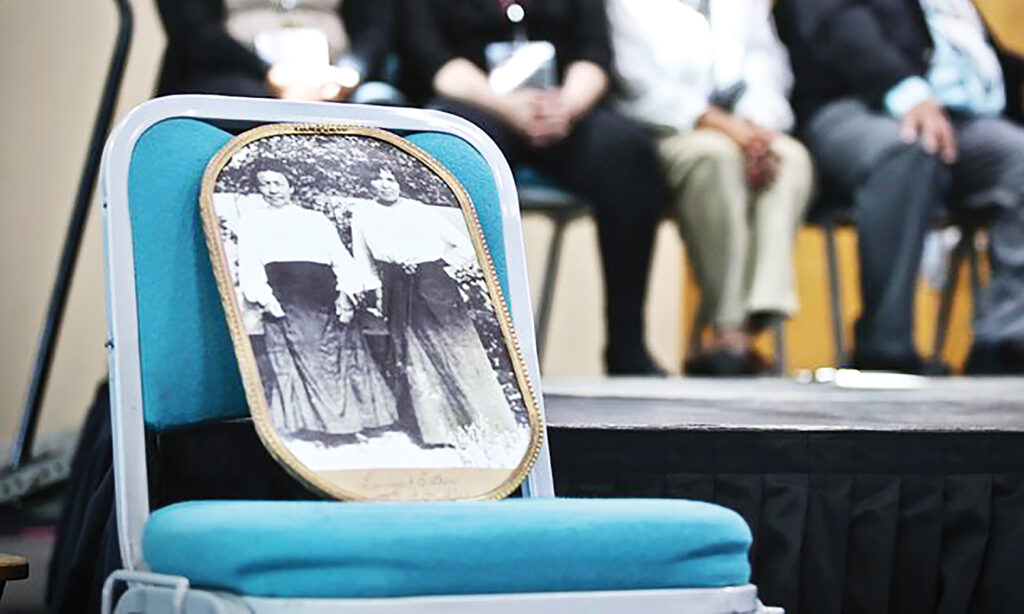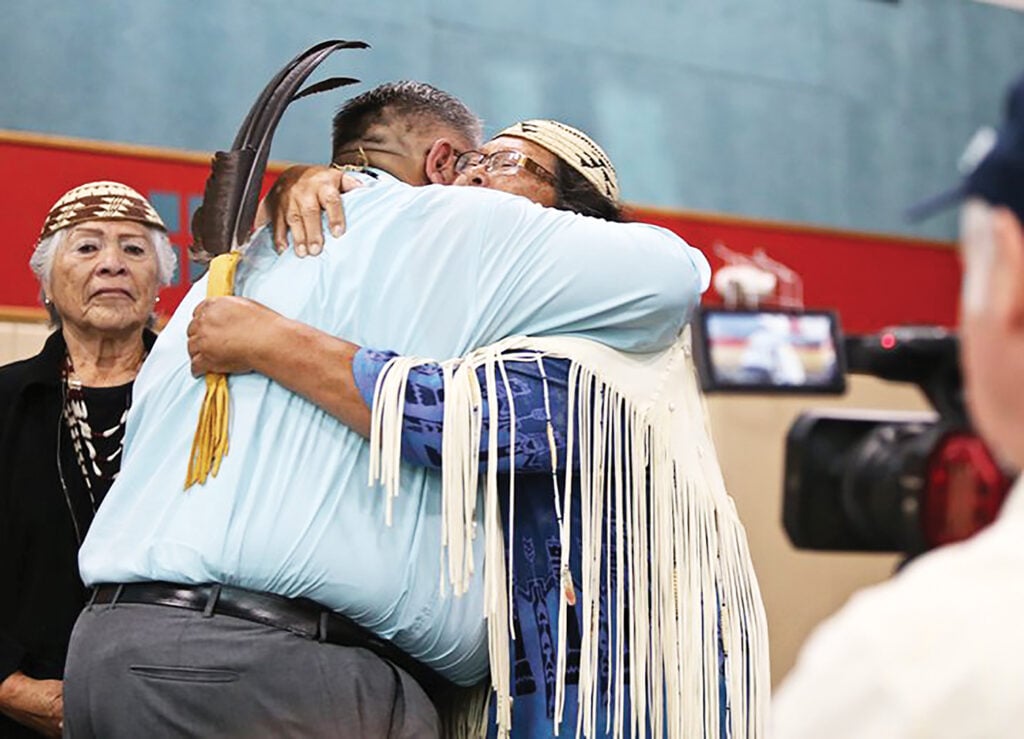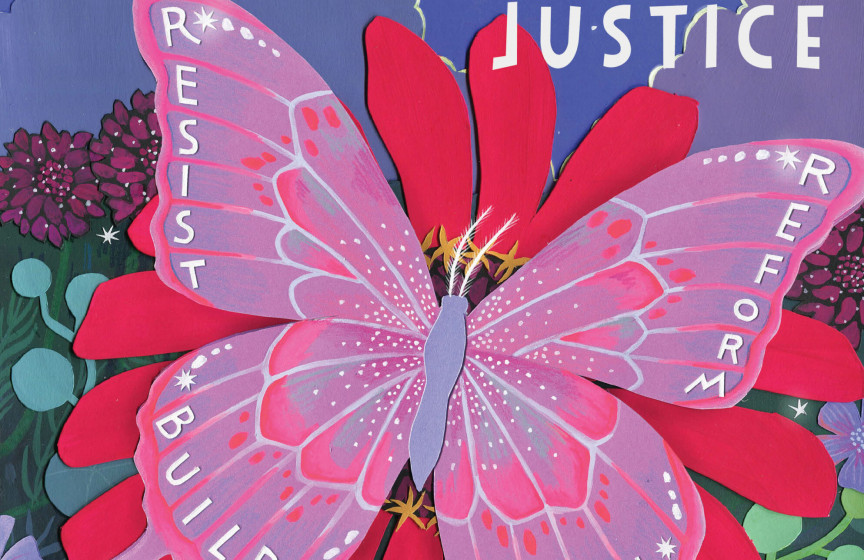A New Social Justice: In Depth
- The Healing Work of Returning Stolen Lands
- Share

Analysis Based on factual reporting, although it incorporates the expertise of the author/producer and may offer interpretations and conclusions.
The Healing Work of Returning Stolen Lands
The Wiyot Tribe regained its sacred island home after decades of unrelenting prayer and relationship-building.
The ancestral home of the Wiyot Tribe, located in what is commonly known as California, is a strikingly beautiful land of marshes, rivers, redwood and spruce trees, inland mountains, and stretches of Pacific coastal beach.
While it has long been a place of refuge for those who love the natural world, it has also been the site of the immense tragedies of the Gold Rush, which resulted in the attempted erasure of Indigenous life and livelihood by the genocidal policies of 19th-century California.
Central to the Wiyot’s ancestral land is Tuluwat Island, a 280-acre island located within Humboldt Bay in what is today the city of Eureka, California. On Feb. 26, 1860, the Wiyot were holding their annual World Renewal Ceremony on the island. A gang of settlers attacked and massacred a majority of the Wiyot, effectively carrying out a genocide. The survivors dispersed themselves and eventually moved to Table Bluff Reservation in the southern region of their homeland.
In the 1970s, Albert James, the son of Jerry James, a survivor of the massacre, had a dream of returning to the island. He approached the city of Eureka with a proposal to that end, but his request was ignored. His dream held power, however, and in the 1990s, James’ nieces Leona Wilkinson and Wiyot Tribal Chairwoman Cheryl Seidner began to organize and act on the proposal.

Wilkinson and Seidner began hosting open prayer vigils to honor what was lost and to rebuild the heart and power of Wiyot people on the island. These vigils brought intergenerational Indigenous people together with settlers who had truth, restoration, and justice in their hearts. Over the years, the vigils created widening circles of education, action, and understanding within the broader tri-county Indigenous and non-Indigenous communities of Northern California, becoming the seeds of the profound healing that can emerge from truth-telling and coming together with love to honor a place.
During this time, the Wiyot discovered that a small part of the island was for sale. The tribe worked with the Seventh Generation Fund, an international Indigenous grant-making and movement-building organization located within the Wiyot homeland, to create the Wiyot Sacred Sites Fund.
More than a simple fundraising effort, the Wiyot Sacred Sites Fund also sold T-shirts and art; hosted community dinners, concerts, and celebrations; and maintained a consistent presence in the Eureka community year after year. After more than a decade of such efforts, the Wiyot were finally able to buy the small parcel of land to heal and restore, all the while continuing to build partnerships with friends and allies, and always carrying with them the dream of the return of Tuluwat.
When the Wiyot received the title to the 1.5-acre parcel of land, they found the land contaminated with toxins—paints, solvents, metals, and petroleum—left over from decades of industrial use such as shipyard operations. Undeterred, tribal members began a cleanup process with volunteer labor and resources.
In 2004, as her uncle did decades before, Seidner approached the city of Eureka, and again requested the return of the island. At that time, the City Council voted unanimously to return 45 acres to the tribe, but with title restrictions.
The Wiyot people and their allies created unique partnerships with local businesses, organizations, and state and federal agencies to orchestrate a remarkable cleanup process that involved an extensive volunteer and partner network across community, city, state, tribal, and federal agencies, organizations, and businesses. The cleanup process was so effective and powerful that it garnered the EPA National Federal Facility Excellence in Site Reuse award.
The efforts benefited the entire ecosystem of plants and marine life, as well as oyster farmers, fishers, and residents. More importantly, in 2014, this work allowed the Wiyot to complete the World Renewal Ceremony that was interrupted in 1860, returning the heart of Wiyot presence and ceremony to the land.
Also in 2014, three Eureka city officials—Mayor Frank Jager and Councilmembers Natalie Arroyo and Kim Bergel—committed themselves to work toward justice for the Wiyot. Arroyo and Bergel approached the Wiyot Tribe to ask what they could do to support them, and were told that the most important thing was to return the remaining city-owned portion of the island.
By 2015, the city of Eureka unanimously passed a resolution to return the island. However, it took four additional years to do the administrative and legal work required for the transfer, including environmental quality assessments, appraisal, and the designation of the land as “surplus.” Finally, on Oct. 21, 2019, the city formally returned Tuluwat Island to the Wiyot Tribe.
It was the first time in the United States that a city government had ever given land back to its ancestral caretakers, and it was a profound testament to the power of the organizing, strength, and vision of Wiyot people.
A small part of the island remains in private hands, but Seidner confirmed that those landowners are peacefully coexisting with their neighbors, saying, “We know how it feels to be taken away from our land.”
Set against the backdrop of the violent and genocidal settler colonialist history of this nation, the movement to restore Tuluwat Island to its original stewards is remarkable.

From LandBack to Indigenous-Led Future Building
The Wiyot are inspiring leaders in a worldwide movement dubbed #LandBack, to protect and restore ancestral lands to the care of Indigenous people. The LandBack movement is a movement born from work that has been done for centuries, and originated with our ancestors fighting to remain within their territories, and maintaining the right to hunt, fish, and gather through direct action and legal battles. It also involves the protection of our sacred sites and homelands from contamination and desecration by industry.
The LandBack movement also includes Indigenous values-based governance of lands that cannot be restored physically, and Indigenous-led work to untangle the conflicting legalities resulting from colonization that restrict self-determination on reservation land. Justice and healing can emerge in powerful ways when Indigenous lands are in Indigenous hands.
The Wiyot Tribe’s success with Tuluwat Island is a powerful example of the international Indigenous LandBack movement. Recently, that movement has manifested in actions like the Red Road to DC journey in summer 2021, aiming to bring awareness of threats to sacred places, and the direct-action work and legal struggle to stop the Line 3 oil pipeline from contaminating ecosystems in the Great Lakes. It has also resulted in political successes such as the introduction of the RESPECT Act in Congress, which would require federal agencies to follow the principles of free, prior, and informed consent by consulting with tribes before pursuing any activity or regulatory action that may have tribal impacts.
Today, using the same model of Indigenous-led, place-based healing that resulted in the return of Tuluwat, Wiyot Tribal Administrator Michelle Vassel and Tribal Chair Ted Hernandez are working with David Cobb and Cooperation Humboldt, a longtime organizational ally, to build a visionary Indigenous-led “restorative economy” within Wiyot ancestral lands. A restorative economy is rooted in land stewardship, care work, equity, collaboration, and sacredness.
Cooperation Humboldt was formed in 2017, inspired by Cooperation Jackson, a cooperative organization working to advance sustainable and equitable development in Jackson, Mississippi. Working since its inception with the Wiyot Tribe, the group recognized early that creating “economies of justice” for all beings begins with responsibility to the ancestral caretakers of the land.
In 2009, the Seventh Generation Fund and Democracy Unlimited, a local political organization, created the Wiyot Honor Tax. The Wiyot Honor Tax is a voluntary tax from people who are “Wiyot homeland residents,” to recognize the history and acknowledge the tenure of the Wiyot people.
Cooperation Humboldt initially committed 1% of its nonprofit revenue to the Wiyot Tribe, then realized quickly that a more integrated commitment was required in order to build a local economy based on justice and honoring the land. The group began reaching out to the Wiyot to offer support, listen, and build good relations.
Hernandez, the tribal chairman, explains, “The folks at Cooperation Humboldt just kept showing up … and frequently and publicly called for other individuals and organizations to pay an honor tax.” He adds, “They worked with us to protect Tsakiyuwit [another Wiyot sacred site] and to begin planning a food forest on the College of the Redwoods campus.”
Cooperation Humboldt went on to partner with the Wiyot Tribe to plan a form of cooperative governance for the tribe’s cultural center and co-host workshops on Soulatluk, the Wiyot language. When the COVID-19 pandemic began, the group also worked with the tribe to build an extensive mutual aid network involving 17 organizations.
Today, the Wiyot Tribe and Cooperation Humboldt have come together to create Dishgamu Humboldt—Dishgamu means “love” in Soulatluk—a groundbreaking Indigenous-led community land trust off of the reservation. The trust forms a foundation for future culturally grounded regenerative development, which serves to regenerate the vitality of the land, people, and culture. The land trust is governed by a board whose structure ensures that the Wiyot Tribe has a decision-making majority.
Dishgamu Humboldt is also set up to be able to receive donations of land, effectively becoming a vehicle for LandBack for the Wiyot Tribe. Building on their legacy of catalyzing partnerships for change, the team of the Wiyot Tribe and Cooperation Humboldt also brought in the values-based investment firm Full Spectrum Capital, working together to create the Gouts Lakawoulh Hiwechk Investment Fund. Gouts Lakawoulh Hiwechk means “money that makes us well” in Soulatluk, speaking to its purpose of seeding an Indigenous, values-based, regenerative economy that benefits all those who live in the Wiyot homeland.
Such an economic system is founded on ideals of healing the relations between people and with the land, and focused on restoration ecology, housing, regenerative forestry, food production and distribution, cooperative business development, and care and wellness.
Dishgamu Humboldt and GLH Investment Fund are now, along with many other collaborators, in predevelopment planning for initial projects, which include a beautiful 40- to 50-unit low-income apartment building designed to enhance ecological and community health. The project includes food production infrastructure and child care, a 47-unit “ecovillage,” and Dishgamu Innovation Center—a place for co-working and building community knowledge for a new economic future based on healing and care of the land and people.
Dishgamu Humboldt is also working with Ikigai Physician Group to assist in financing a trauma-informed, community-driven health care model, and discussing the creation of a women’s and children’s hospital and birthing center to respond to the closure of a regional obstetrics unit.
The story of the Wiyot Tribe’s LandBack journey continues to inform and inspire others; from the return of Tuluwat Island, to the restoration of the tribe’s care and guidance, to intercultural community development within its homelands. This is the unshakable foundation on which we can build Indigenous-led futures that honor the land, community, and our collective liberation.

